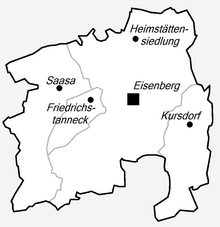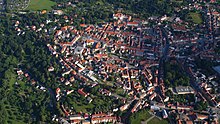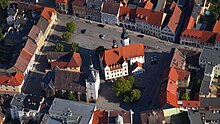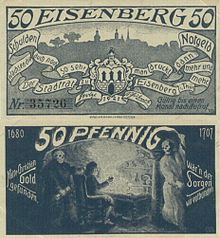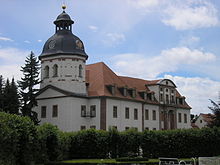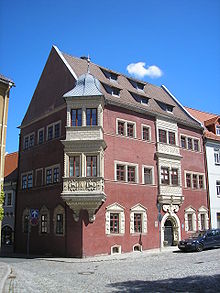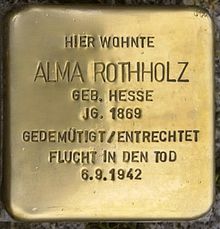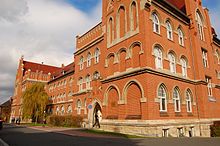Eisenberg (Thuringia)
| coat of arms | Germany map | |
|---|---|---|
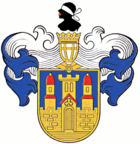
|
Coordinates: 50 ° 58 ' N , 11 ° 54' E |
|
| Basic data | ||
| State : | Thuringia | |
| County : | Saale-Holzland district | |
| Fulfilling municipality : | for Gösen for Hainspitz for Mertendorf for Petersberg for Rauschwitz |
|
| Height : | 290 m above sea level NHN | |
| Area : | 24.67 km 2 | |
| Residents: | 10,849 (Dec. 31, 2019) | |
| Population density : | 440 inhabitants per km 2 | |
| Postal code : | 07607 | |
| Area code : | 036691 | |
| License plate : | SHK, EIS, SRO | |
| Community key : | 16 0 74 018 | |
| City structure: | 4 districts | |
City administration address : |
Market 27 07607 Eisenberg |
|
| Website : | ||
| Mayor : | Michael Kieslich ( CDU ) | |
| Location of the city of Eisenberg in the Saale-Holzland district | ||
Eisenberg is the district town of the Saale-Holzland district in Thuringia and is halfway between Jena and Gera .
geography
geology
Eisenberg is located in the area of the Saale-Elster sandstone slab in a hilly landscape surrounded by moderate heights, the vegetation of which consists partly of deciduous and coniferous forest. Geologically, it consists mainly of red sandstone .
Eisenberg lies for the most part on a plateau that extends around 275 meters above sea level from west to east. In the south and north of the city the ground drops steeply into two valleys in which the Malzbach and Raudabach stream flow. In the northwest is the Beuche, a wooded hill consisting of shell limestone , which merges into the Thuringian hill country.
City structure
The city of Eisenberg consists of the historic old town and recent city extensions. The Heimstätten settlement is located about one kilometer north of the city center. In the Raudatal, south of the old town, there are eight water mills along the stream. After Eisenberg the former neighboring communities Friedrichstanneck , Saasa and finally Kursdorf (March 8, 1994) were incorporated.
Neighboring communities
Neighboring communities are Gösen , Hainspitz , Heideland , Petersberg , Rauda , Silbitz , Tautenhain and Weißenborn . Eisenberg is divided into the four districts of Kernstadt, Friedrichstanneck, Saasa and Kursdorf. The northern entrance to the Eisenberger Mühltal , a popular excursion destination, is located near Kursdorf .
climate
The average annual precipitation from 1961 to 1990 at the Eisenberg measuring station is 646 mm and is therefore below the German average, with the exception of April and August. The driest month is February, with the most rainfall in June and August.
history
Origins to 1900
There is evidence that the city's roots go back to the Stone Age . Eisenberg Castle was the predecessor of the current castle. It was built in the 12th century by order of the Margrave of Meißen. It was rebuilt in the 16th century, then expanded from 1677–1692 under Duke Christian von Sachsen-Eisenberg to become the Christiansburg Castle, which is still preserved today and named after him.
In the corridor of the incorporated district of Kursdorf there is a burial mound south of the "Alte Straße", which has been damaged by former military exercises. In “Jagen 88” there are two grave mounds from the Neolithic Age.
As early as 1171 there was a city fortification. In 1219 the Eisenberg Cistercian convent was established by moving the Zwickau monastery and equipping it with the goods of the Augustinian canon monastery, which had recently moved there from Camburg . In 1219 the city was first mentioned as "civitas". In 1256 several citizens were named. From the 13th century landgrave ministerials are proven.
In 1450 the Jacob's Chapel in what is now the state forest of Hainspitz is said to have been destroyed in the Saxon fratricidal war . The stones were used at the end of the 16th century to build the church in today's Saasa district and the Hundertmark'schen house on the market in Eisenberg. Remnants of the chapel existed until the 18th century.
In 1485 Eisenberg in Electoral Saxony fell to the Ernestines when Leipzig was divided . The Reformation was introduced in 1524 . From 1681 to 1707 the city was the residence of the Duchy of Saxony-Eisenberg , after which it belonged to Saxony-Altenburg until 1918 . Eisenberg was the seat of the Eisenberg district office .
In 1880 the railway line to Crossen was built, followed by its western continuation to Porstendorf to the Saalbahn near Jena in 1905 . The line to Porstendorf / Jena was closed in 1969 and that to Crossen / Gera in 1999.
1900 until now
During the Nazi era , small communist and social democratic groups resisted Nazi rule. A circle around the Social Democrats Heinz Schubert and Friedrich Singer distributed educational pamphlets that they received from Czechoslovakia through the exile executive of the SPD ( Sopade ) . During the Second World War , at least 326 forced laborers from Eastern Europe were employed in companies that manufactured armaments, in companies in the wood processing, furniture manufacturing, leather and footwear industry, metal processing, instrument and apparatus manufacturing, the chemical and pharmaceutical industry and porcelain manufacturing. A memorial in the cemetery, renovated in 1974, commemorates 53 victims of forced labor from 27 nations, including 35 prisoners on a concentration camp death march . Another memorial stone commemorates 17 children of forced laborers who died.
On February 9, 1945, two US B-17 bombers ("Flying Fortresses") collided in the area between Jena and Eisenberg after one of them had been damaged by flak . The stern of the other had been torn off in the collision and he fell in the Mühltal , 50 meters north of the parish mill. Eight crew members were killed, the rear gunner was able to save himself. Before the crash, the machine got rid of its bombs over Eisenberg. Although these did not explode, they destroyed two houses, damaged others and killed ten people.
On April 9, 1945, the station, locomotives and track systems were attacked very effectively by US bombers with high explosive and incendiary bombs and by fighter bombers with bombs and on-board weapons. Houses were also hit and two people died.
Eisenberg was occupied by the US Army around April 13, 1945 and handed over to the Red Army in early July . So it became part of the Soviet occupied zone SBZ and from 1949 the GDR.
At the beginning of the 1950s, the Eisenberg Circle was formed in Eisenberg , a resistance group of high school students who, relying on the tradition of resistance against National Socialism, planned and carried out actions against SED rule.
On October 25, 1989, a prayer for peace took place in the overcrowded Luther Hall. A demonstration march then formed through Eisenberg. Every Wednesday, basic democratic rights were demanded every week, and soon the unity of Germany as well.
In Eisenberg there is the central reception center of the Free State of Thuringia for refugees and asylum seekers from all over the world. The building reflects German history for the past 150 years. It was built in 1870 as a sausage factory, later it was a retirement home, a military hospital in both world wars, then barracks for the NVA and the People's Police and (until 1979) a reception center for people emigrating from the FRG to the GDR. At the end of 2013 it housed over 500 people.
Population development
The population development of the city of Eisenberg is shown in the following table:
|
|
|
Data source from 1994: Thuringian State Office for Statistics
politics
City council
The city council of Eisenberg consists of 24 council members. This is the specified number for a municipality with a population between 10,001 and 20,000. The 24 council members are elected by local elections for five years each.
The full-time mayor directly elected by the citizens is also entitled to vote in the city council.
The last local election on May 26, 2019 led to the following result with a turnout of 49.7% (2014: 45.9%):
| Party / list | Share of votes | +/-% p | Seats | +/- |
| CDU | 44.7% | + 15.7 | 11 | + 4 |
| SPD | 18.5% | - 8.5 | 4th | - 2nd |
| The left | 17.1% | - 8.8 | 4th | - 2nd |
| FDP | - | - 3.0 | 0 | - 1 |
| BDS * | 19.7% | + 5.1 | 5 | + 1 |
* Association of the Self-Employed, 2014: BDS / DGV Association of the Self-Employed / German Trade Association e. V.
mayor
Michael Kieslich (CDU) has been mayor since July 1, 2018.
The full-time mayor of the city of Eisenberg was Ingo Lippert from the SPD from 2000 to 2018 . Lippert was temporarily suspended from duty on June 29, 2015. Findings from the investigations into disciplinary proceedings (official offense for which, among other things, a fine of 33,000 euros was imposed by the Jena jury in April 2014) justified the assumption that "Mr. Lippert will be finally removed from the civil servant status in the context of the pending disciplinary action". The 1st alderman Götz Witkop temporarily took over the official business.
From 1990 to 2000, Burkhardt Wartner was mayor of Eisenberg.
Fulfilling Church
Eisenberg is the fulfilling community for the places:
coat of arms
The coat of arms of the city of Eisenberg consists of a tinned golden city wall with a tinned gate tower and closed gate. Behind the wall to the left and right of the main tower are two tinned side towers with red bell roofs. The center of the two side towers and the pointed roof of the gate are also in red. The base of the shield is limited by four transverse lines. Between the body of the Moor and the coat of arms there is a golden spade helmet with light decorations. The Moor's head wears a white bandage over his eyes and looks to the right. Half of the heraldic shield is framed by a blue and white saddle pad.
The city's coat of arms adorns the wall, the gate and the three towers, which stand for urban freedom, public spirit and a sense of strength, as well as a Moor's head. This goes back to a legend from the Middle Ages (around the 16th century), according to which a Moor brought by a duke from the crusades was accused of stealing a chain from the duke's wife and was supposed to be beheaded. Shortly before his execution, the countess found the alleged stolen property in her Bible and sent a messenger to the place of execution just in time, so that the innocent Moor was spared. To restore his honor, his head with the blindfold should adorn the city coat of arms.
In 1727, a statue of the Moor, who is the city's landmark, was erected behind the town hall on a fountain base.
logo
The city of Eisenberg uses its own logo for different purposes . It consists of a geometrically constructed small Latin e, which is cut through by a cross of lines. The color of the logo is blue on a white background. The upper right quarter can be designed variably and offers space for the coat of arms or for other themed symbols.
flag
The city's flag shows the colors blue and white lengthways with the city's coat of arms in the middle.
Town twinning
Eisenberg maintains city partnerships with the following cities:
- Eisenberg (Pfalz) , Rhineland-Palatinate, Germany
- Menden (Sauerland) , North Rhine-Westphalia, Germany
- Stadthagen , Lower Saxony, Germany
- Soissons , Picardy , France
Culture and sights
Buildings
From 1680 to 1707 the city of Eisenberg was the residential city of the Duchy of Saxony-Eisenberg . Under Duke Christian von Sachsen-Eisenberg , Christiansburg Palace was redesigned into a baroque three-wing complex. Today the castle is the seat of the district administration. A special feature is the castle church of St. Trinitatis , which the duke had built from 1680 to 1692 on the east side of the castle. It is considered the most beautiful baroque church in the state of Thuringia
On the market square in Eisenberg there are three free-standing buildings as well as the Mohrenbrunnen , which is the landmark of the city of Eisenberg. The Eisenberg town hall standing in the southwest corner of the market square was first mentioned in 1576. In the 16th century, several renovations were carried out in the Renaissance style . In 1702/1703 the town hall tower was raised and an oriel was added. In 1999 the city won the federal award for the most beautiful town hall.
The town church of St. Peter is on the north side of the market square . It was mentioned as a chapel as early as 1219 in the founding document of the Eisenberg nunnery. The church consists of the late Gothic choir from 1494, the nave built in 1585 and the church tower, the date of which is not certain.
The third building on the market square is the Eisenberg City Museum in the so-called Klötzner House. The building of the wealthy businessman Karl Friedrich Klötzner (1853–1932) came into the possession of the city in 1911 and initially served as a residential building. In 1984 the city council decided to set up a city museum, which was not opened until 1992. It shows the Eisenberg urban development from early history to industrialization .
Friedrichstanneck Palace, west of the city center, is currently in ruins .
→ See also cemetery chapel (Eisenberg)
Parks
The Eisenberg zoo was opened in 1971 and shows small breeds of domestic animals, wild animals from Australia and from African mountain regions as well as native forest inhabitants.
The castle park adjoining the castle with arched garden and fountain as well as the peace park between the town hall and the catholic church are ideal for walks.
Monuments
In the Eisenberg cemetery on Mühlenstrasse, three objects are supposed to keep the memory of the time of National Socialism , the Second World War and the post-war period alive. A memorial commemorates 35 concentration camp prisoners buried in the cemetery. They died on a death march in Eisenberg and the surrounding area when the concentration camps were cleared in April 1945, shortly before the end of the Second World War . A memorial stone with the inscription “Here, far from home, 17 children of forcibly displaced Eastern workers between the ages of 1 and 15 are resting. Her death is a reminder of eternal peace. ”Remembers 17 children of forced laborers who died of insufficient supplies and who also found their final resting place in the Eisenberg cemetery.
Another memorial stone with the inscription “IN MEMORY OF THE VICTIMS OF WORLD WAR II, THE ESCAPE AND DISPLACEMENT, INJUSTICE AND VIOLENCE” commemorates all victims of this time.
In Friedrich-Ebert-Straße at Friedenspark and in Geraer Straße at the parking lot to the zoo there are more memorial stones for the march of the prisoners of the Buchenwald concentration camp through Eisenberg.
In the Saasa district, a grave with a plaque commemorates four young children of Soviet forced laborers who were deported to Germany during the Second World War . On the village square there is a memorial for the victims of war and tyranny (former war memorial of the First World War ).
There are two monuments in the palace garden. The Duke Christian monument is right next to the palace church. In the rear part of the park a memorial stone with its copper relief commemorates the Reichstag deputy and chairman of the KPD Ernst Thälmann (1886–1944), who was killed in the Buchenwald concentration camp in August 1944 . The Thälmann memorial is a former Bismarck memorial that was repurposed during the GDR era.
Other monuments are the Krause memorial on Krauseplatz behind the Eisenberg police station and a memorial to the atomic physicist Frédéric Joliot-Curie between the former boys' school (now part of the district office in Schulgasse) and the East elementary school.
In 1993, Jörg Petermann took the initiative to erect a memorial stone for the ten victims of the bombing on February 9, 1945 in Jenaer Strasse in Eisenberg and for the eight crew members who died afterwards in the Mühltal near the impact point of their "flying fortress" Boeing B-17 above the parish mill set.
On June 19, 2015, a stumbling block for Alma Rothholz was laid in the sidewalk in front of the house at Burgstrasse 13 , with the active participation of citizens, representatives of the city administration and the Jewish community .
Regular events
From the calendar of events of the city of Eisenberg, the following regular events with great regional awareness are worth mentioning:
- June: City Festival Eisenberg®
- July: Trabi meeting in the traffic garden
- August: Tiergarten Festival
- September: Open Monument Day - Art in the Arch Garden
- October: Milo Barus Cup in Mühltal ( weight training tournament in memory of Milo Barus )
- October: Eisenberger Landmarkt
- December: Eisenberg night Christmas market
- December: Christmas valley Mühltal
Economy and Infrastructure
economy
The abundance of forests in the Thuringian Timber Country also shaped the city's industrial profile. Piano making has a tradition of almost 200 years, which is still carried out today by the Wilhelm Steinberg piano manufacturer . Other main branches of industry are sanitary fittings with the headquarters of Sanitary Technology Eisenberg and a production site for Armaturenwerke Kludi und Möbel ( Eisenberger Wohnmöbel (EWM)). In the company vocational school of the VEB Möbelkombinat Eisenberg u. a. trained most of the GDR piano makers. The EthikBank is also based in Eisenberg. In 1995 Stadtwerke Eisenberg , which had originally existed since 1898, was re-established.
Since the establishment of the first Eisenberg porcelain factory by Heinrich Ernst Mühlberg from Roschütz near Gera in 1796, several porcelain factories have been founded. The last new establishment of a porcelain factory took place in 1900 by the company Porzellanfabrik Kalk GmbH with the last porcelain fire in 1991 in VEB Vereinigte Porzellanwerke (Kahla-Porzellan GmbH), Eisenberg plant, Werkstrasse 5, which ended before the Second World War and partly also during the GDR - Years, for the city economically important porcelain industry .
traffic
Eisenberg is on the B 7 federal highway , which runs from Rochlitz in Saxony to Düsseldorf in North Rhine-Westphalia . Via the B 7, it is connected to the nearby federal autobahn 9 , junction Eisenberg / Thuringia and to the federal autobahn 4 , junction Gera-Langenberg. The Hermsdorfer Kreuz motorway junction is eleven kilometers south of Eisenberg , where the A 4 and A 9 intersect.
Eisenberg is the largest city and, besides Schleiz, the only district town in Thuringia that no longer has a rail connection. The railway line to Crossen was opened in 1880 by the Eisenberg-Crossener Eisenbahn-Gesellschaft and closed in 1999, the western part of which via Bürgel to Jena was opened in 1905 and closed in 1969.
The JES Verkehrsgesellschaft , which is also based in Eisenberg, runs every hour with midibuses on the city line 401. Furthermore, the most important localities in the region can be reached using the JES Verkehrsgesellschaft and RVG / Regionalverkehr Gera Land GmbH. B. Jena, Hermsdorf, Gera (all three with train connections), Bürgel, Camburg and Stadtroda.
Medical supplies
The Eisenberg Forest Clinics , which were named after the orthopedist Rudolf Elle until 2017 and have made a name for themselves with their orthopedic department, are located in Eisenberg . The facility also houses the chair for orthopedics of the Medical Faculty of the Friedrich Schiller University Jena . The forest clinics also have a department for surgery, a department for internal medicine , a department for anesthesia and intensive care medicine and a pediatric orthopedics department . Attached to the hospital is a medical supply store , which provides prostheses and aids for patients.
media
The Ostthüringer Zeitung appears every working day with its own local section for Eisenberg. After massive savings in the editorial department, there are now only three editors in the Eisenberg local editorial office. Many articles and contributions from the local pages are taken from Jena and Stadtroda .
The "Allgemeine Anzeiger" advertising paper appears weekly in Eisenberg with a local section from the Saale-Holzland district . The editorial team has been in Jena since March 2012. The newspaper was previously produced in Hermsdorf .
education
There are four state schools in Eisenberg: two elementary schools (East, "Martin Luther"), a regular school "Karl Christian Friedrich Kause" (merged from the former regular schools West and East) and the Friedrich Schiller Gymnasium .
Personalities
Honorary citizen
- Edgar von Thaler (1927–2019), Lutheran clergyman and superintendent (1965 to 1992)
sons and daughters of the town
- Johann Michael Heineccius (1674–1722), Lutheran clergyman and historian
- Johann Gottlieb Heineccius (1681–1741), professor of law and philosophy
- Johann David Gschwend (1691–1767), author who published the first chronicle about Eisenberg in 1758.
- Daniel Gottfried Werner (* 1695), school man and Protestant theologian
- Karl Christian Friedrich Krause (1781–1832), philosopher
- Bruno Bauer (1809–1882), philosopher
- Moritz von Sachsen-Altenburg (1829–1907), Prussian general of the cavalry
- Felix Frommelt (1842–1886), consul in Sarajevo
- Emil Böhme (1873–1930), politician (SPD), member of the Thuringian state government, district administrator
- Otto Procksch (1874–1947), Old Testament scholar
- Günter Ranft (1901–1945), stage designer, church painter
- Gerhard Buchwald (1920–2009), physician
- Alfred Tischendorf (* 1934), wrestler
- Thomas Ammer (* 1937), historian, GDR opposition activist and victim of the dictatorship in the GDR
- Peter Lesser (* 1941), ski jumper
- Gunther Emmerlich (* 1944), singer and entertainer
- Klaus Olshausen (* 1945), Lieutenant General ret. D. the Bundeswehr
- Ralf Strogies (* 1966), former soccer player and soccer coach
- Michael Tetzlaff (* 1973), writer
Other personalities
- Christian von Sachsen-Eisenberg (1653–1707), only Duke of Sachsen-Eisenberg
- Immanuel Johann Gerhard Scheller (1735–1803), classical philologist and lexicographer, attended high school in Eisenberg between 1747 and 1752
- Charlotte von Sachsen-Meiningen (1751–1827), Duchess of Sachsen-Gotha-Altenburg, lived in Eisenberg for a few years
- Georg von Sachsen-Altenburg (1796-1853), Duke of Sachsen-Altenburg, resided alternately in Altenburg and Eisenberg
- Otto Hammann (1852–1928), lawyer, attended grammar school in Eisenberg
- Ernst Wasserzieher (1860–1927), etymologist, lived in Eisenberg between 1884 and 1888
- Ernst II von Altenburg (1871–1955), Duke of Saxony-Altenburg, attended the Christian School in Eisenberg between 1886 and 1889
- Georg Kunze (1880–1942), second mayor of the city and communist resistance fighter against the Nazi regime, murdered in Ichtershausen prison in 1942 , honored with street names and memorial plaques during the GDR era
- Karl Kleinschmidt (1902–1978), Protestant Lutheran pastor, cultural politician and publicist, pastor of the city until 1931
- Rudolf Elle (1911–1952), orthopedist
- Peter Landau (1935–2019), legal scholar, went to school in Eisenberg
- Elke Maes (* 1943), politician (CDU), teacher in Eisenberg between 1978 and 1987
- Bernward Müller (* 1950), politician (CDU), active in Eisenberg from 1977
- Ute Seifarth (* 1953), singer (including Berlin steamers and Ute & Jean )
- Helmut Zapf (* 1956), composer, cantor at the town church in Eisenberg between 1979 and 1982
literature
- August Leberecht Back: Chronicle of the city and the office of Eisenberg from the earliest times to the year 1843. 2 volumes. Schöne, Eisenberg 1843.
- Karl Back : The old Eisenberg. Contributions to the history of the times, places and customs of the city of Eisenberg in earlier centuries. Schöne, Eisenberg 1839, ( digitized version ).
- Eisenberg. In: Johann Heinrich Zedler : Large complete universal lexicon of all sciences and arts . Volume 8, Leipzig 1734, columns 617-620.
- Friedrich Gotthelf Gotter: Kurtze reliable news, from the Lutheri who confessed to Eisenberg before the Reformation, and the Blessed Virgin Mary, also afterwards the famous nun's closter consecrated to Saint Creutz. Fleischer, Eisenberg 1730, ( digitized version ).
- Johann David Gschwend : Eisenberg city and country chronicle. Walther, Eisenberg 1758, ( digitized version ).
- Paul Heinecke: Narrated and documented. From history and legend in the Eisenberg area. Illustrations by Wolfgang Tietze. Zentralhaus publication, Leipzig 1983.
- Eckhart Leisering: Acta sunt hec Dresdene ... the first mention of Dresden in the document of March 31, 1206 (= publications of the Saxon archive administration. Series B: Kleine Schriften. Vol. 3). mvd - Mitteldeutscher Verlag, Halle / Saale 2005, ISBN 3-89812-320-0 , pp. 13 / 51–52: Explanations on the Civitas Eisenberg and on Hugo de Ysenberc.
- Wilfried Warsitzka: Citizens under the Moors coat of arms . From the history of the city of Eisenberg and its inhabitants. Bussert & Stadeler, Jena u. a. 2010, ISBN 978-3-942115-01-8 .
Web links
Individual evidence
- ^ Population of the municipalities from the Thuringian State Office for Statistics ( help on this ).
- ^ City of Eisenberg: Introducing the city , accessed on July 9, 2013.
- ↑ Michael Köhler: Thuringian castles and fortified prehistoric and early historical living spaces. Jenzig-Verlag Köhler, Jena 2001, ISBN 3-910141-43-9 , pp. 73 and 75.
- ↑ Sven Ostritz (Ed.): Saale-Holzland-Kreis, Ost (= Archaeological Hiking Guide Thuringia. Issue 9). Beier & Beran, Langenweißbach 2007, ISBN 978-3-937517-51-3 , pp. 73 and 75.
- ↑ Sven Ostritz (Ed.): Saale-Holzland-Kreis, Ost (= Archaeological Hiking Guide Thuringia. Issue 9). Beier & Beran, Langenweißbach 2007, ISBN 978-3-937517-51-3 , p. 78.
- ↑ Thuringian Association of the Persecuted of the Nazi Regime - Association of Antifascists and Study Group of German Resistance 1933–1945 (Ed.): Local history guide to sites of resistance and persecution 1933–1945. Volume 8: Thuringia. VAS - Verlag für Akademische Schriften, Frankfurt am Main 2003, ISBN 3-88864-343-0 , p. 208 f.
- ↑ Ulrike Kern and Jörg Petermann: The plane crash over the Mühltal 75 years ago is still moving . Thuringian State Newspaper, February 8, 2020
- ^ Günter Sagan: East Thuringia in the bombing war 1939-1945. Michael Imhof, Petersberg 2013, ISBN 978-3-86568-636-7 , p. 185.
- ^ Eisenberger Kreis on jugendopposition.de, accessed on December 19, 2010.
- ↑ Information board at the Eisenberg town church.
- ^ Bernd Stöver : Refuge GDR. Spies and other emigrants . CH Beck, Munich 2009, ISBN 978-3-406-59100-6 .
- ↑ Ulrich Stoll: Once freedom and back. The history of returnees from the GDR . Ch. Links, Berlin 2009, ISBN 978-3-86153-544-7 .
- ↑ Daniela Egetemayer: You ring the doorbell at the iron gate in the middle of the night. In: Thüringische Landeszeitung , December 10, 2013.
- ↑ Thuringian municipality and district regulation (Thuringian municipal regulation - ThürKO -) in the version of the announcement of January 28, 2003; § 23 - Composition of the municipal council , accessed on July 8, 2013.
- ^ City of Eisenberg .
- ^ Judgment of BM Lippert , accessed on September 4, 2015.
- ↑ Press release impeachment , accessed on September 4, 2015.
- ↑ Four places - one name: Eisenberger from all over the world . ( otz.de [accessed on April 9, 2018]).
- ↑ a b c Main statutes of the city of Eisenberg / Thuringia (PDF; 38 kB), accessed on July 6, 2013.
- ↑ Rudolf Zießler , State Curator: Speech on the 300th anniversary of the church inauguration (1992)
- ↑ Information brochure for the Eisenberg City Museum. P. 3.
- ↑ Small steps - big impact: Eisenberg , accessed on November 17, 2013.
- ↑ Christian Ahrens, Friederike Böcher, Sigrid Eul, Birgit Goede (eds.): Pianos solidest construction. 170 years of piano manufacturing in Eisenberg / Thuringia (= monographs of the Heinrich-Schütz-Haus research and memorial site, Bad Köstritz. 2 = series of specialist books on musical instruments. 56). Bochinsky, Frankfurt am Main 1993, ISBN 3-923639-96-1 .
- ↑ Waldkrankenhaus Rudolf Elle in Eisenberg , accessed on July 6, 2013.
- ↑ Eisenberg's honorary citizen has died , Ostthüringer Zeitung of August 24, 2019
- ^ Eisenberg city and country chronicle. Walther, Eisenberg 1758.



